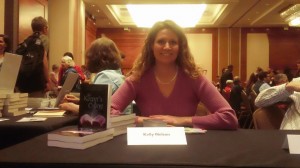Show Don’t Tell: It is the difference between actors acting out an event and the lone playwright standing on a bare stage recounting the events to the audience. –Janet Evonivich
Showing has action at its core. Analyze the Meaningful vs. Mundane ~Tell the boring stuff: setup, dull but necessary actions, filler dialogue. Then show the interesting stuff. Use showing and telling to contrast between the meaningful and the mundane. If you showed everything, nothing would stand out.
Writing over the Gap ~ The story you’ve shown | gap | The story of the reader’s experience
The writer will fill in the gap, feel things, and come to conclusions based on their experiences. Don’t give your reader the conclusion or the explanations. Give them the imagery to come to the right conclusions. Don’t write on the reader’s side of the line. For a reader to be engaged in a story they must have things to figure out.
Visible vs. Invisible ~ What is visible and what is not seen but inferred by how the visible things are manifested. Invisible things are what is inside, friendship, socioeconomic status, type of person, these things are on the reader’s side of the gap and shouldn’t be told. A reader’s conclusion/inference is more believable to them than something the author tells them. Remember, we are our own most credible source. Seeing it for ourselves is the most reliable evidence. Let your readers see your story for themselves.
Why show?
- Because showing is more vivid and interesting
- Inferences are where the fun is
- Information density is incredibly high
Why tell?
- What’s happening isn’t meaningful
- To maintain pacing
Give visible details as seen through the characters eyes and then let the reader come to an opinion about it.
When to show?
- You want the reader to feel something
- You need the reader to infer something
- To call attention to something
When to tell?
- At scene breaks, to jump in time
- To summarize mundane but necessary events
Remember, the event doesn’t cause the emotional impact. It is the reader’s reaction to what they saw and their inference of the event that makes the impact.
What to show?
- Show what’s meaningful
- Show what helps the reader’s over the gap
- Show the visible manifestations of the invisible.
What to tell?
- Everything else (never tell us what you really want us to know) Show it! Make the words matter.
How to show?
- Figure out your invisible facts
- Find moments where they come into play
- Determine the visible consequences
- Write them down
Surprise the reader: Look for unexpected metaphors/similes “I shook the sledgehammer on the end of his arm and tried to smile.” Use words in an unexpected context.
Telling vs. Fancy Telling vs. Showing ~ Fancy telling is still telling. Write down the actions of your characters.
Beware of info dumps & backstory. Learn to weave them into the action.
Dialogue tags can be tells, i.e. “says accusingly.” Use strong showing verbs instead of adverbs to tell the manner of action. See http://amwriting.org/archives/10062
Streamline your dialogue. Skip the A & D of a dialogue sequence and focus on the B & C. This means you don’t need to write out all the niceties of introduction and the pleasantries of easing out of the conversation, such as “Hello. How are you?” or “Thanks. Tell your wife hello for me.” We say these things all the time, but they don’t need to be in our writing for every conversation.
Find the right spot to jump into each conversation.
Beware of exclamation marks in your narrative. They don’t work. It is like begging the reader to feel something.
Inner monologue can be a great way to show the characters thoughts instead of narrating them.
Thank you, Jason, for a great presentation. You can visit Jason Black, the Book Doctor, at his website: www.PlotToPunctuation.com
My next 2 blog posts will feature my notes from Robert Dugoni and Donald Maass, who both spoke at the Pacific Northwest Writers Association Conference held in Seattle July 19-21, 2012. What a fabulous conference, full of many opportunities to improve your writing and pitch to agents and editors. I loved being able to sit on the “Author” side of the table at the mass book signing event Friday night! Two years ago I was pitching to agents and praying for a chance to get published. I am so grateful Walnut Springs Press took a chance on me. I am thankful for all you wonderful readers out there who have embraced The Keeper’s Calling and have let Chase and Ellie touch your lives as they did mine.







